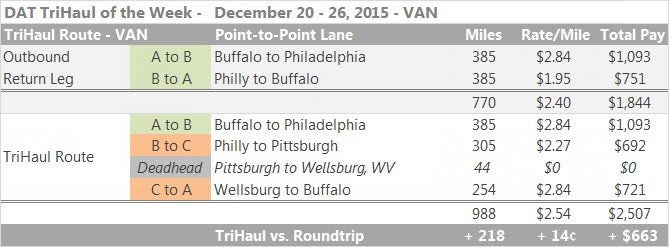‘Twas a short work week before Christmas. By Wednesday afternoon, not a truck was stirring.
Typically, when a four-day work week follows a five-day week, there are 20% fewer workdays, so you’d expect a 20% decline in all load board activity. That’s not what happened, though. Freight brokers offered four days’ worth of loads for vans, and five days’ worth of loads for reefers, but most truckers were not interested in working even the full four days.
Who can blame them? Owner-operators were not about to post their trucks on Christmas Eve. And if a bigger fleet accepted any new loads on Tuesday or Wednesday of last week, most of those would be short hauls and local deliveries, to get the drivers home for Christmas. Nobody wants to be Scrooge.
Anyway, the difference in brokers’ and carriers’ holiday schedule preferences caused an increase in load-to-truck ratios across the board.
Taking all that into account, there were still some interesting trends by equipment type: Reefer demand declined only 1% week over week, which is the same as an increase (see above.) Van demand was about equal to the previous week’s load count (down 22%, because of the four-day week) and flatbed load posts were down, no matter how you measure them.
Fuel prices dropped again last week, triggering a 1¢ decline in the surcharge. So where rates stayed the same, it was because the line haul portion of the rate went up by a penny. (Freight brokers tend to quote an “all-in” rate for the trip, but DAT RateView calculates a rate per mile with and without the fuel surcharge, so you can compare contract rates to spot market rates for a given lane, and get an apples-to-apples comparison.)
Van and reefer rates were unchanged, as a national average. It seems likely that the mix favored short-haul lanes over long-haul for the week, due to the holiday. That trend was partly responsible for the extra penny added to the line haul, to offset the decline in the fuel surcharge.
Weather adds to pricing pressure, and the weather was truly awful last week in some big markets – most notably Dallas – that are responsible for big spot market freight volume.
Expect rates to trend up a little more this week, as shippers accelerate freight movements to close the year on a high note. This should affect vans and reefers more than flatbeds. We’ll probably see an increase in load posts, and maybe truck posts too, compared to last week. I am guessing that most people are less sensitive about working on New Year’s Eve than on Christmas Eve.

The national average rate held steady for vans last week at $1.71 per mile, despite a 1¢ decline in the fuel surcharge. Outbound rates increased for van loads originating in Dallas, Chicago, Atlanta and Philadelphia, but van rates declined in Los Angeles, Memphis and Buffalo. Rates were affected by weather as well as last-minute freight shipments in the days before Christmas.

Van load posts slowed by 22% and truck posts declined 33%, during the week leading up to Christmas. A 20% decline in load board activity can be attributed to the short holiday week. Last-minute demand and severe weather also contributed to an increase in the load-to-truck ratio, which rose from 1.6 to 1.9 loads per truck. Loads were readily available, and trucks are relatively scarce, in a handful of Hot Markets, including: Twin Falls, ID; Bismarck, ND; Des Moines, IA; Rock Island, IL; Hutchinson, KS; Kansas City and Joplin, MO; Memphis, TN; Columbia, SC, and pretty much all of Alabama. A shortage of trucks yielded high load-to-truck ratios that also turned the map red in Wyoming, Mississippi, New Hampshire and Maine, despite lower freight volume.
 Van TriHaul for the New Year:
Van TriHaul for the New Year:
Buffalo – Philadelphia – Pittsburgh – Buffalo
You may not be looking for any more loads this week, especially if you want to be home for New Year’s Eve. Consider this route for next week, to start you off strong in 2016. Start in Buffalo, Philly or Pittsburgh, and keep moving in the headhaul direction, on high-volume lanes.

You should be able to find loads, even during the slow season. If you want to secure your loads now for next week, there may be fewer options on the load board, so you could end up with some deadhead. This TriHaul still works pretty well, giving you an average of $2.54 per mile for all miles of the roundtrip, even if you drive empty for 50 miles.
Demand and capacity information is based on load and truck posts from DAT Load Boards. Rates are derived from DAT RateView and are based on actual rate agreements between freight brokers and carriers. Reference rates include fuel surcharges but not accessorial or other fees. TriHaul route suggestions are offered in DAT Express and DAT Power load boards.


